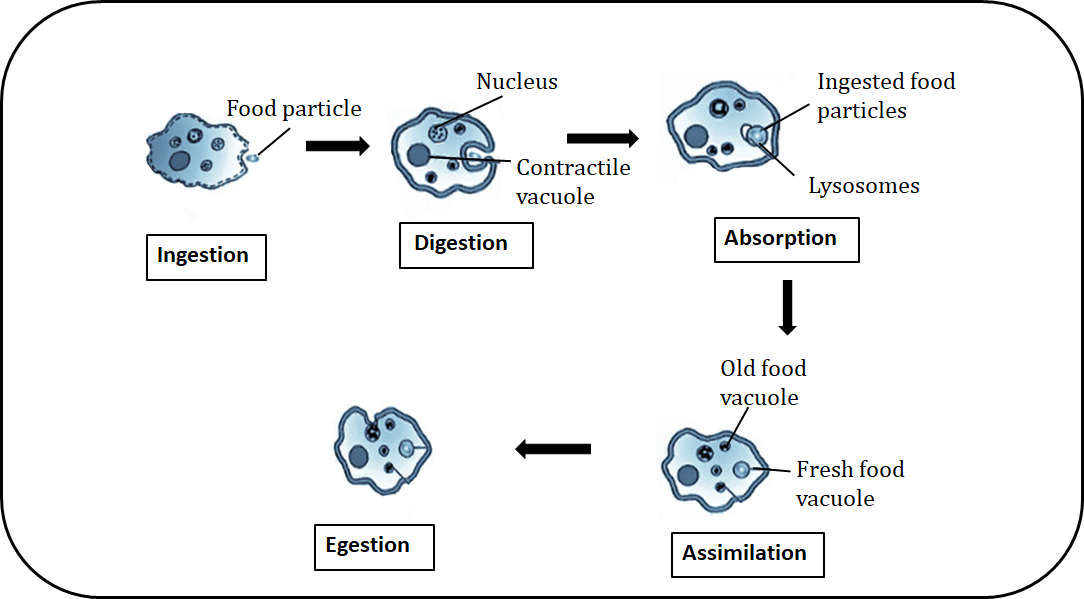
Describe the process of nutrition in amoeba. Draw a labeled diagram to show the various steps of nutrition in amoeba.
Answer
508.8k+ views
Hint: Nutrition in amoeba occurs through a process called phagocytosis. In this process, the entire organism engulfs the solid food particles.
Complete answer:
In Amoeba, the mode of nutrition is known as holozoic nutrition that involves the ingestion, digestion, and egestion of foodstuffs. Amoeba is a unicellular organism. It has the ability to alter its shape. Amoebas are generally parasitic or free-living in damp environments.
Nutrition in amoeba includes the following process:-
Ingestion - Amoeba has no mouth for the ingestion of food. It ingests the food by using its pseudopodia. The food is engulfed forming a food vacuole.
Digestion- The food is digested by digestive enzymes present in the cytoplasm which breaks the food into small soluble molecules by chemical reactions.
Absorption: The digested food present in the food vacuole diffuse into the cytoplasm. After this, the food vacuole disappears.
Assimilation - Assimilation is a process that involves the gain of energy from food through respiration and the remaining part of the food is used for growth.
Egestion: The undigested food material moves to the surface of the cell where it is thrown out of the body.
Note:
1. In some amoeba, nutrition takes place by pinocytosis which is also known as fluid endocytosis in which the small particle suspended in extracellular fluid and brought into the cell through the invagination of the cell membrane that resulted in a suspension of particles within a small vesicle inside the cell.
2. The source of food varies among amoebae. Some amoebae are detritivores that eat dead organic matter while some are predatory and live by consuming bacteria and protists.
Figure: Steps involved in the nutrition of amoeba

Complete answer:
In Amoeba, the mode of nutrition is known as holozoic nutrition that involves the ingestion, digestion, and egestion of foodstuffs. Amoeba is a unicellular organism. It has the ability to alter its shape. Amoebas are generally parasitic or free-living in damp environments.
Nutrition in amoeba includes the following process:-
Ingestion - Amoeba has no mouth for the ingestion of food. It ingests the food by using its pseudopodia. The food is engulfed forming a food vacuole.
Digestion- The food is digested by digestive enzymes present in the cytoplasm which breaks the food into small soluble molecules by chemical reactions.
Absorption: The digested food present in the food vacuole diffuse into the cytoplasm. After this, the food vacuole disappears.
Assimilation - Assimilation is a process that involves the gain of energy from food through respiration and the remaining part of the food is used for growth.
Egestion: The undigested food material moves to the surface of the cell where it is thrown out of the body.
Note:
1. In some amoeba, nutrition takes place by pinocytosis which is also known as fluid endocytosis in which the small particle suspended in extracellular fluid and brought into the cell through the invagination of the cell membrane that resulted in a suspension of particles within a small vesicle inside the cell.
2. The source of food varies among amoebae. Some amoebae are detritivores that eat dead organic matter while some are predatory and live by consuming bacteria and protists.
Figure: Steps involved in the nutrition of amoeba

Recently Updated Pages
Basicity of sulphurous acid and sulphuric acid are

Master Class 12 Economics: Engaging Questions & Answers for Success

Master Class 12 Maths: Engaging Questions & Answers for Success

Master Class 12 Biology: Engaging Questions & Answers for Success

Master Class 12 Physics: Engaging Questions & Answers for Success

Master Class 4 Maths: Engaging Questions & Answers for Success

Trending doubts
Give 10 examples of unisexual and bisexual flowers

Draw a labelled sketch of the human eye class 12 physics CBSE

a Tabulate the differences in the characteristics of class 12 chemistry CBSE

Differentiate between homogeneous and heterogeneous class 12 chemistry CBSE

Why is the cell called the structural and functional class 12 biology CBSE

Differentiate between insitu conservation and exsitu class 12 biology CBSE




